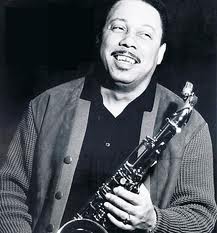Translation – Eli "Lucky" Thompson
This laid-back swinger is based on the changes of the standard What's New. First and second parts are available as well as a Concert Condensed Score.
- Recording: Lucky Thompson - Featuring Oscar Pettiford, Vol. 1
- Recorded on: January 30, 1956
- Label: ABC-Paramount (ABC 111)
- Concert Key: C
- Vocal Range: , to
- Style: Swing (medium)
- Tenor Sax - Lucky Thompson
- Trombone - Jimmy Cleveland
- Piano - Hank Jones
- Bass - Oscar Pettiford
- Drums - Osie Johnson
0:00
0:00
Buy MP3
Video
- Description
- Historical Notes
- Solos
- Piano Corner
- Bass Corner
- Drum Corner
- Guitar Corner
- Inside & Beyond
- Minus You
For this song, the standard What's New has been "translated" to a swinging new post-bop head on the same changes.What's New is frequently played as a ballad, so the possibilities offered by these changes at a medium tempo such as this are not often explored. Unlike the original song, the melody on the bridge is not a transposition of the A section melody.
The lead sheet editions feature a single instrument playing the melody. You can play Lucky's original two-horn arrangement using the Tenor Sax 1st part and Trombone 2nd part editions.
About the arrangement: The horns play the melody mostly in unison or octaves, going into harmony at the end of each eight-measure phrase as well as at the third measure of the A and C sections. The Concert Condensed Score shows the horn parts in treble clef, an octave higher than they sound.
For the lead sheet, most of the melody is written in the register that Lucky plays on the recording; the exception is the first two measures, where because of the lower unison horns it is written an octave higher. In this range, it makes sense to include the lower notes of the third measure's two-part harmony as the melody.
The out head on the recording is taken from the bridge; on the lead sheet we have made the bridge the D.S., but show the option of returning to the beginning (D.C.) for the whole head out.
The lead sheet editions feature a single instrument playing the melody. You can play Lucky's original two-horn arrangement using the Tenor Sax 1st part and Trombone 2nd part editions.
About the arrangement: The horns play the melody mostly in unison or octaves, going into harmony at the end of each eight-measure phrase as well as at the third measure of the A and C sections. The Concert Condensed Score shows the horn parts in treble clef, an octave higher than they sound.
For the lead sheet, most of the melody is written in the register that Lucky plays on the recording; the exception is the first two measures, where because of the lower unison horns it is written an octave higher. In this range, it makes sense to include the lower notes of the third measure's two-part harmony as the melody.
The out head on the recording is taken from the bridge; on the lead sheet we have made the bridge the D.S., but show the option of returning to the beginning (D.C.) for the whole head out.
This first of the two Thompson-Pettiford albums, like the second , was recorded in two sessions: one with a trio and the other with a quintet. The trio personnel is the same as on Volume 2 (as heard on Little Tenderfoot and The Plain But The Simple Truth), while the quintet heard here differs from Volume 2's quintet (N R #1, N R #2, and a trio from the same session on Once There Was) only by the presence of pianist Hank Jones instead of Don Abney.
In between the recording of these two albums, Lucky went to Paris and recorded To A Mornin' Sunrise, among many other original compositions.
Interested in learning more about Lucky Thompson? Check out historian Noal Cohen's site.
In between the recording of these two albums, Lucky went to Paris and recorded To A Mornin' Sunrise, among many other original compositions.
Interested in learning more about Lucky Thompson? Check out historian Noal Cohen's site.
Related Songs
Email Send Translation to a friend
Send this page to a friend via email. Add your name or email in the first field. In the second, add one or more email addresses, separated by a comma.

Eli "Lucky" Thompson
June 16, 1923 – July 30, 2005
Saxophonist Lucky Thompson is one of the great treasures of jazz. He was born in Columbia, South Carolina, but was raised in Detroit, Michigan. He played in local groups with Hank Jones, Sonny Stitt and others. In August, 1943, when he was 19, he left Detroit with Lionel Hampton's Orchestra, eventually arriving in New York City. Still a teenager, his first recording date was with Hot Lips Page on March 18, 1944. Later in 1944 he started recording with both Lucky Millinder and Count Basie. Read more...
There was a problem.
...

